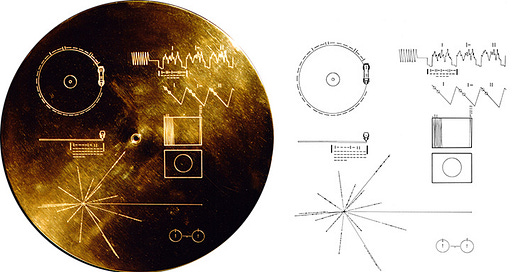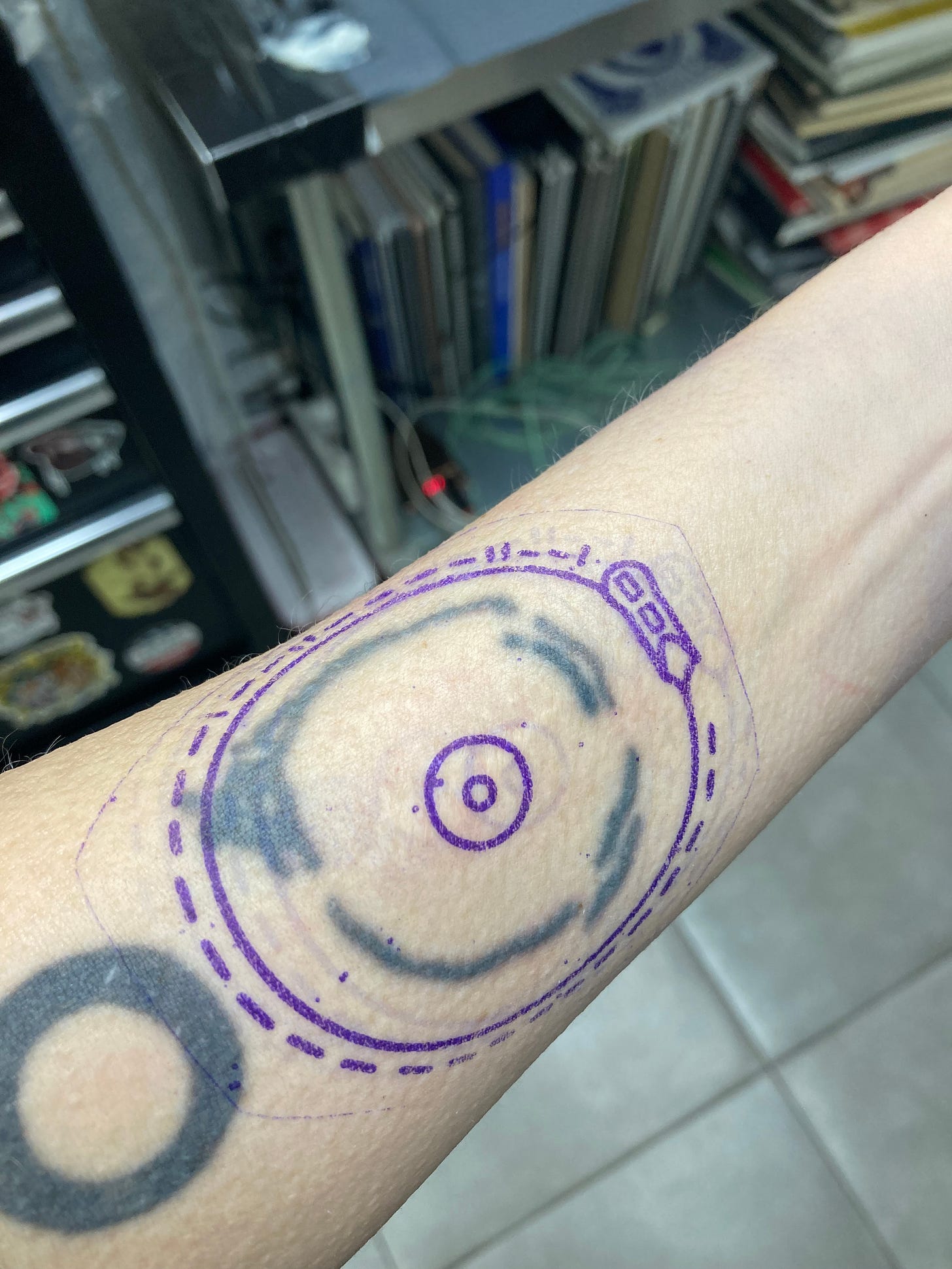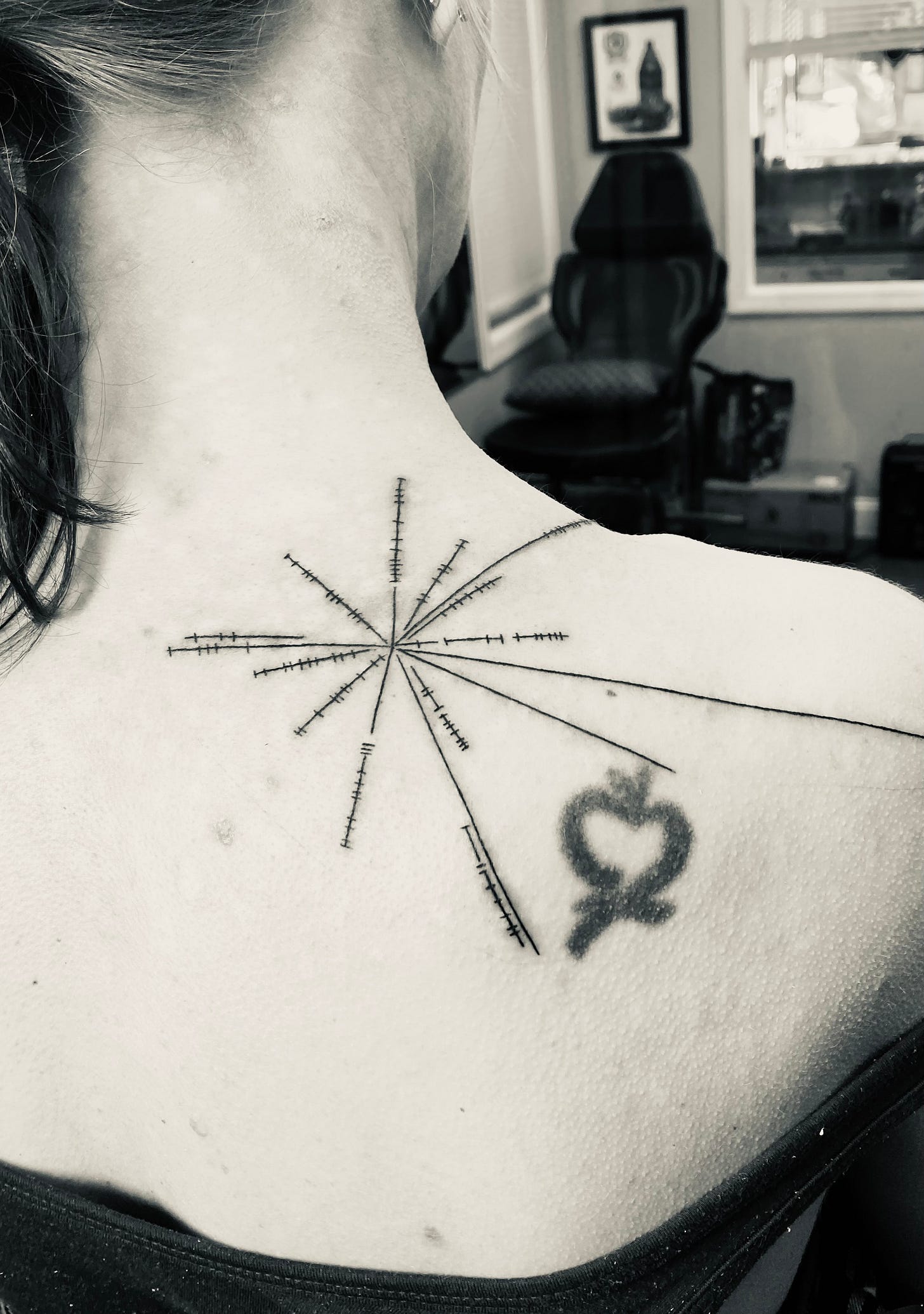For Valentine’s Day, I wrote about the love story underneath the making of the Golden Record hurtling through outer space since 1977. Now in honor of National Space Day, I’ll take it out for a spin again. When it comes to the myriad possible complications of interstellar travel, redundancy is key; there are actually duplicate records on twin Voyager ships. The records, produced in a project led by Carl Sagan, contain a time capsule of the Best of Earth—samples of our languages, art, nature sounds, images, music—and, on the record surfaces: coded instructions for the alien beast who someday may scratch its weirdly shaped head(s) on how to pair a disc with its included player.
That’s all sweet and artsy, but the twin Voyagers (1 and 2), for the last 46 years (a few years shy of my life span), have also been doing other things beyond just transporting a gilded LP to deep space nowhere on the off chance of exotic extrahuman contact. For the effort and expense behind them, these missions were only meant to last five years, but now are, according to this recent CNN article, “the longest operating spacecraft in history” and “humanity’s most distant spacecraft in the cosmos.” The initial goal was to swing by Jupiter, Saturn, Uranus and Neptune gathering scientific insights on our solar system, which they did decades ago. Miraculously, and beyond all expectation, they sustain and keep trucking:
The probes are currently venturing through uncharted cosmic territory along the outer reaches of the solar system. Both are in interstellar space and are the only spacecraft ever to operate beyond the heliosphere, the sun’s bubble of magnetic fields and particles that extends well beyond the orbit of Pluto.
Voyager 2, which is operating normally, has traveled more than 12.6 billion miles (20.3 billion kilometers) from our planet.
When such a long life is an unexpected surprise (like someone with a fatal cancer diagnosis who against all odds survives decades), you can’t much complain about the glitches and technicalities of aging—it’s all a gift. The ships, which should connect to earth in constant communication and data dumps, have gone offline for months on end with antennae mis-orients and other random dropouts, only to resurface and/or be restored again, with their ever-troubleshooting earth crew more amused than annoyed.
“We never know for sure what’s going to happen with the Voyagers, but it constantly amazes me when they just keep going,” said Voyager Project Manager Suzanne Dodd, in a statement. “We’ve had many anomalies, and they are getting harder. But we’ve been fortunate so far to recover from them. And the mission keeps going. And younger engineers are coming onto the Voyager team and contributing their knowledge to keep the mission going.”
I think of the other day when my friend hosted an intimate little living room birthday/housewarming dinner in her new apartment, and sitting alongside me on the couch was the most active and engaged 96-year-old you’ll ever meet. Barbara was talking about still taking ballroom dance lessons (though she preferred the Argentine Tango for the close embrace the instructor could use to keep her upright), and hosting peer workshops for writers (though monthly instead of weekly). The party ended when it was time for the host to help drive her home and everyone rose to find her shoes, a cane, or hold an arm to assist in descending the steep stairs. It felt really soul-enriching to encounter such positive aging and supportive community in a time that is often so isolating for everyone, especially our most senior seniors.
Voyager 1 at the time of this CNN article last week, currently 15 billion miles away, had gone quiet for five months but seemed to have come back online again. In November, among its “multiple quirks and signs of aging in recent years,” it had been sending an “indecipherable repeating pattern of code.” Dementia?
Voyager 1’s flight data system collects information from the spacecraft’s science instruments and bundles it with engineering data that reflects its current health status. Mission control on Earth receives that data in binary code, or a series of ones and zeroes.
But since November, Voyager 1’s flight data system had been stuck in a loop. While the probe has continued to relay a steady radio signal to its mission control team on Earth over the past few months, the signal did not carry any usable data.
The mission team received the first coherent data about the health and status of Voyager 1’s engineering systems on April 20. While the team is still reviewing the information, everything they’ve seen so far suggests Voyager 1 is healthy and operating properly.
Should, at the age of 96 (or 46 in spacecraft years), we all be so lucky as to have our relative physical health and minds intact enough, bolstered by such a faithful team to prop us up, get us down the stairs and into cars, and before that, remember to invite us to the party in the first place—which, by the way, even contained an improv acting game Barbara readily played along with. One difference between a person in our midst and the Voyagers at large is the great time delay. Messages aren’t immediately received in space. A radio signal takes 22.5 hours to travel each way, while the person next to you on the couch can hear and respond to you right this minute. If you’re present and speak clearly it can be very gratifying. Lean in, listen.
Because at this apex of midlife I find myself single again (the clumsy experiment continues), and because I retain an endless if childlike belief in the wild pursuits of space exploration and romance, I thought it was a fine time to celebrate myself and this tail end of the passing of the comet of age 50 with a few new tattoos.
Imagine if muckier matters, especially ourselves, came with a manual and a map. Humans need the same how-to handle each other bullet points as we do for troubleshooting our tech. In this vein, I borrowed two graphics from the surface of the record. On my forearm, the instructions for how to play the record, showing the stylus and the blips around the ring for its RPM.
Or as NASA says in more appropriate jargon:
In the upper left-hand corner is an easily recognized drawing of the phonograph record and the stylus carried with it. The stylus is in the correct position to play the record from the beginning. Written around it in binary arithmetic is the correct time of one rotation of the record, 3.6 seconds, expressed in time units of 0,70 billionths of a second, the time period associated with a fundamental transition of the hydrogen atom. The drawing indicates that the record should be played from the outside in.
Then on my shoulder blade, the map showing where our sun is in the galaxy. Again, says NASA:
The drawing in the lower left-hand corner of the cover is the pulsar map previously sent as part of the plaques on Pioneers 10 and 11*. It shows the location of the solar system with respect to 14 pulsars, whose precise periods are given. [*Pioneers 10 and 11, which preceded Voyager, both carried small metal plaques identifying their time and place of origin for the benefit of any other spacefarers that might find them in the distant future.]
Could someone find me and crack my code? Or better yet, could I find and crack myself? These are highly imperfect if “permanent” gestures. Old marks mix with new, scars with faded tattoos of yesteryear’s Very Important Things, an extracted birthmark relined with crisp thin lines. Some optimistically scrutable history of a life, my greatest hits.
What would you put into a time capsule commemorating your life? I think I might put some things not about me directly (not selfies or honors) but the works I’ve created—my books, my kids, my art. (I mean not the kids themselves, though that’s tempting, perhaps some photos of them will do.) Creating something of substance that may have a life beyond my life has been the meaning of life, for me. Mattering in a very literal sense, by making matter.
Ultimately it’s all a love story, isn’t it, this Golden Record, these ink marks here in words and there on skin. How we love earth, how we project ourselves into space, how we want to share with language, images and objects who and how we are. How we might better love ourselves first. When I tattooed these renderings on my body indelibly, it was a nod to the love story embedded in this mission, how Ann’s elevated heart rate in the throes of her newfound love for Carl is recorded for prosperity, or however long these ships travel until they implode, or just go missing—never to be known what became of our high hopes, specks of dust in deep space. I commit to finding great love when I also know I already have it.








Lovely piece, Krista. And yes, great tattoo concept.
I like to imagine what happened when the team at NASA fixed Voyager I. What should we do? It's 22 light hours away!
"Let's try magic thought bullets, I guess."
Astounding that they could get it working again.